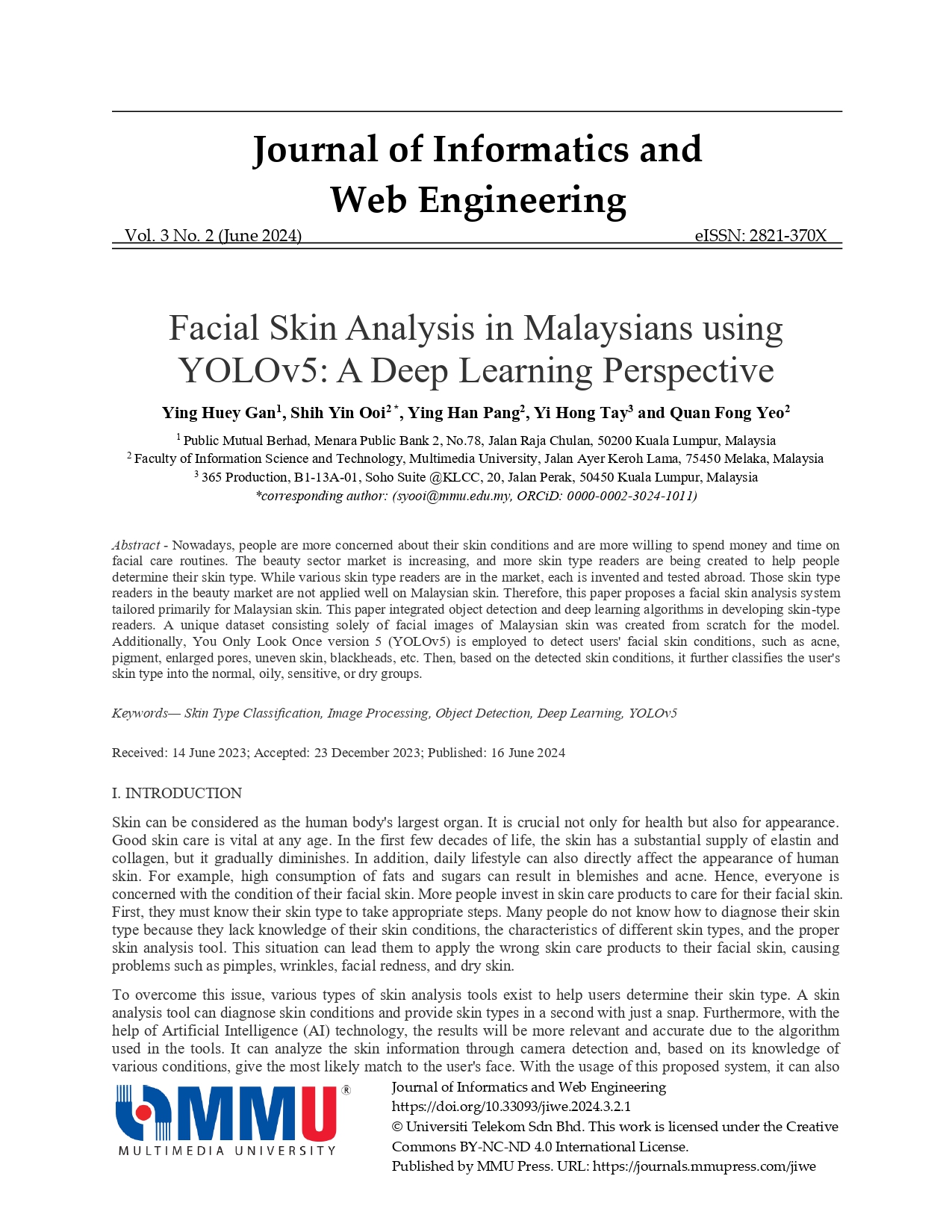Facial Skin Analysis in Malaysians using YOLOv5: A Deep Learning Perspective
Main Article Content
Abstract
Nowadays, people are more concerned about their skin conditions and are more willing to spend money and time on facial care routines. The beauty sector market is increasing, and more skin type readers are being created to help people determine their skin type. While various skin type readers are in the market, each is invented and tested abroad. Those skin type readers in the beauty market are not applied well on Malaysian skin. Therefore, this paper proposes a facial skin analysis system tailored primarily for Malaysian skin. This paper integrated object detection and deep learning algorithms in developing skin-type readers. A unique dataset consisting solely of facial images of Malaysian skin was created from scratch for the model. Additionally, You Only Look Once version 5 (YOLOv5) is employed to detect users' facial skin conditions, such as acne, pigment, enlarged pores, uneven skin, blackheads, etc. Then, based on the detected skin conditions, it further classifies the user's skin type into the normal, oily, sensitive, or dry groups.
Article Details

This work is licensed under a Creative Commons Attribution-NonCommercial-NoDerivatives 4.0 International License.
All articles published in JIWE are licensed under a Creative Commons Attribution-NonCommercial-NoDerivatives 4.0 International (CC BY-NC-ND 4.0) License. Readers are allowed to
- Share — copy and redistribute the material in any medium or format under the following conditions:
- Attribution — You must give appropriate credit, provide a link to the license, and indicate if changes were made. You may do so in any reasonable manner, but not in any way that suggests the licensor endorses you or your use;
- NonCommercial — You may not use the material for commercial purposes;
- NoDerivatives — If you remix, transform, or build upon the material, you may not distribute the modified material.
References
O.K. Pal (2021). Skin Disease Classification: A Comparative Analysis of K-Nearest Neighbors (KNN) and Random Forest Algorithm. Proceedings of International Conference on Electronics, Communications and Information Technology, ICECIT 2021. https://doi.org/10.1109/ICECIT54077.2021.9641120
T. Parashar, K. Joshi, R.N. Ravikumar, D. Verma, N. Kumar, & K.S. Krishna (2022). Skin Disease Detection using Deep Learning. Proceedings of the 2022 11th International Conference on System Modeling and Advancement in Research Trends, SMART 2022, 1380–1384. https://doi.org/10.1109/SMART55829.2022.10047465
K.V. Swamy, & B. Divya (2021). Skin Disease Classification using Machine Learning Algorithms. Proceedings of the 2021 2nd International Conference on Communication, Computing and Industry 4.0, C2I4 2021. https://doi.org/10.1109/C2I454156.2021.9689338
V. Vasudha Rani, G. Vasavi, & B. Maram (2022). Skin Disease Classification Using Machine Learning and Data Mining Algorithms. Proceedings - 2022 IEEE 2nd International Symposium on Sustainable Energy, Signal Processing and Cyber Security, ISSSC 2022. https://doi.org/10.1109/ISSSC56467.2022.10051620
H.T. Chan, Y.W. Liao, S.Y. Jhong, S.C. Chien, K.L. Hua, & Y.Y. Chen (2023). A Skin Type Classification Method Using Mobile Device-Based Deep Learning Model. 2023 9th International Conference on Applied System Innovation, ICASI 2023, 199–201. https://doi.org/10.1109/ICASI57738.2023.10179572
D. Hecht, T. Pfahler, I. Ullmann, T. Altstidl, N. Amer, Y. Jin, B. Eskofier & M. Vossiek (2022). In Vivo Skin-Type Classification Using Millimeter-Wave Near-Field Probe Spectroscopy. 2022 52nd European Microwave Conference, EuMC 2022, 404–407. https://doi.org/10.23919/EUMC54642.2022.9924376
J.C. Dunn (1973). A Fuzzy Relative of the ISODATA Process and Its Use in Detecting Compact Well-Separated Clusters. 3(3), 32–57. https://doi.org/10.1080/01969727308546046
J.C. Bezdek (1981). Pattern Recognition with Fuzzy Objective Function Algorithms. https://doi.org/10.1007/978-1-4757-0450-1
J.-d. Lee, Y.-c. Chen, L.-c. Liu, & C.-h. Huang (2007). A Facial-skin Condition Classification System Using Texture and Fuzzy C-means Technologies. https://doi.org/10.1109/FSKD.2007.22
L.A. Zadeh (1965). Fuzzy Sets. https://doi.org/10.1016/S0019-9958(65)90241-X
Y.P. Huang, Y.Z. Li, & C.C. Lin (2013). Smart Phone-Based Fuzzy Modeling to Examine Facial Skin Quality. ICSSE 2013 - IEEE International Conference on System Science and Engineering, Proceedings, 69–74. https://doi.org/10.1109/ICSSE.2013.6614635
C. Cortes, & V. Vapnik (1995). Support-Vector Networks Editor. In Machine Learning (Vol. 20). https://dx.doi.org/10.1007/BF00994018
T.Y. Lin, H.T. Chan, C.H. Hsia, & C.F. Lai (2022). Facial Skincare Products' Recommendation with Computer Vision Technologies. Electronics (Switzerland), 11(1). https://doi.org/10.3390/electronics11010143
Y. Lecun, L. Bottou, Y. Bengio, P. Haffner (1998). Gradient-Based Learning Applied to Document Recognition. https://doi.org/10.1109/5.726791
A. Kothari, D. Shah, T. Soni, & S. Dhage (2021). Cosmetic Skin Type Classification Using CNN With Product Recommendation. 2021 12th International Conference on Computing Communication and Networking Technologies, ICCCNT 2021. https://doi.org/10.1109/ICCCNT51525.2021.9580174
K. He, X. Zhang, S. Ren, & J. Sun (2015). Deep Residual Learning for Image Recognition. https://doi.org/10.48550/arXiv.1512.03385
S. Sharma (2020). DermaDetect: A Novel Computer Vision Model for An Accurate Diagnosis of Skin Conditions and Rashes. Proceedings - 2020 IEEE 7th International Conference on Data Science and Advanced Analytics, DSAA 2020, 743–744. https://doi.org/10.1109/DSAA49011.2020.00094
G. Jocher, A. Chaurasia, A. Stoken, J. Borovec, NanoCode012, Y. Kwon, K. Michael, TaoXie, J. Fang, imyhxy, Lorna, Y. Zeng, C. Wong, V. Abhiram, D. Montes, Z. Wang, C. Fati, J. Nadar, Laughing, UnglvKitDe, V. Sonck, tkianai, yxNONG, P. Skalski, A. Hogan, D. Nair, M. Strobel, M. Jain. (2022). ultralytics/yolov5: v7.0 - YOLOv5 SOTA Realtime Instance Segmentation. https://doi.org/10.5281/zenodo.7347926
J. Chhatlani, T. Mahajan, R. Rijhwani, A. Bansode, & G. Bhatia (2022). DermaGenics - Early Detection of Melanoma using YOLOv5 Deep Convolutional Neural Networks. 2022 IEEE Delhi Section Conference, DELCON 2022. https://doi.org/10.1109/DELCON54057.2022.9753227
J.J. Ng, K.O.M.Goh, & C.Tee (2023). Traffic Impact Assessment System using Yolov5 and ByteTrack. Journal of Informatics and Web Engineering. 2(2), 168-188. https://doi.org/10.33093/jiwe.2023.2.2.13
J.-R. Lee, K.-W, Ng, & Y.-J, Yoong (2023). Face and Facial Expressions Recognition System for Blind People Using ResNet50 Architecture and CNN. Journal of Informatics and Web Engineering. 2(2), 284-298. https://doi.org/10.33093/jiwe.2023.2.2.20
Q. F. Yeo, S. Y. Ooi, Y. H. Pang, and Y. H. Gan, “Facial Skin Type Analysis Using Few-shot Learning with Prototypical Networks”, International Journal on Advanced Science, Engineering and Information Technology, vol. 13, no. 6, pp. 2249–2266, Dec. 2023.

